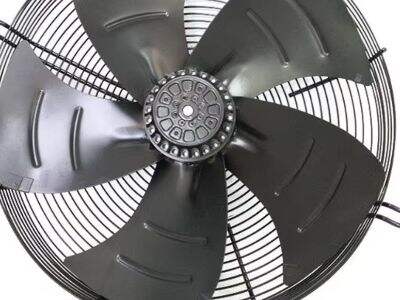dit is 'n amusante sake, maar dit is baie belangrik om die regte koelventilator te kies. Die tipe fan wat jy kies sal baie belangrik wees vir hoe koel jou masjiene of jou toerusting bly. As jy wil voorkom dat dinge te warm word, het jy die regte tipe fan vir die taak nodig. Daar is twee primêre tipes fans wat mense gebruik — asimptote fans en sentrifugale fans. Elkeen van hulle het hul voordele en nadele. So, watter een werk die beste vir jou koelbehoeftes? Lat ons meer oor hulle leer.
Asimptote vs Sentrifugale Fans: 'n Vergelyking
Kom ons begin met asiale wensels. Asiale wensels is soos die plafonwensels wat jy in 'n kamer kan vind, egter is hierdie wensels bedoel om op die vloer te staan of aan 'n muur vasgemaak te word. In 'n asiale wensel draai die blare rondom 'n middelpunt, wat lug in 'n lynêre rigting dwing. Hierdie draai bewerkstellig 'n baie kragtige lugvloed wat areas vinnig kan afkoel. Hulle is veral goed vir gevalle wat betekenislike lug nodig het, maar nie soveel druk nie. Boonop word hulle gebruik in die afkoeling van rekenaanleg of warmte-ruilingsapparate, wat 'n baie kritieke benadering is om dinge koel te hou. Asiale wensels is ook tipies meer koste-effektief en energie-efektief, wat hulle 'n aantreklike opsie maak vir gebruikers wat hul omgewings wil afkoel sonder om teveel uit te gee.
Nou, na centrifugale wensels. Hierdie wensels funksioneer 'n bietjie anders. By 'n aswensel kan jy dit verbeeld soos 'n stofzuiger. In plaas van om lugh te blaas in 'n reguit lyn, beweeg die lug deur die wensel op 'n 90-gradige hoek. Hierdie ontwerp help om hoë-druk lugvloed te skep, wat ideaal is vir die skuif van lug in areas waar lugbeweging benodig word. Dit is die rede waarom centrifugale wensels wonderbaar is vir hoë-druk vereistes, soos in fabrieksomgewings of in verwarming- en koelsisteme (HVAC). Lae Gerois: Een van die beste kenmerke van 'n centrifugale wensel is dat hulle stil loop. Dit maak hulle 'n geskikte opsie vir plekke wat stil gehou moet word, byvoorbeeld werksplekke of noodklinieke, waar lawaaierige gerois probleme kan wees.
Kies 'n Tegnologie wat die Beste as 'n Lugkoeler Werk
Daar is 'n paar dinge wat jy in ag moet neem wanneer jy die regte koelfana kies vir jou koelbehoeftes. Jy moet die lughede, drukvlakke en geraas in ag neem. Dit is ook belangrik om te weet hoeveel lug jou stelsel benodig om korrek te koel. Neem ook die grootte en tipe van jou koelstelsel in ag, asook wat die koelbehoeftes van jou toerusting is. Hieronder volg goeie herinnerings om in ag te neem wanneer jy besluit:
As jy 'n hoë volume lug nodig het teen lae druk, is asskewerfans die manier om te gaan. Hulle kan asemloos groot volumes lug vinnig en op 'n energie-effektiewe wyse beweeg.
Voor toepassings waar jy baie druk nodig het en 'n lagere lugvloed (soos dit soms in woonhuis-toepassings gebeur), is sentrifugale fans geskik. Hulle het spierkracht en kan lug met krag beweeg.
As jy albei nodig het, is dit ook moontlik om albei tipes fans te gebruik. Dit kan 'n goeie manier wees om die beste van albei werweltjies vir jou koeling te kry.
En gelaas mag nie oor die kispegvlakke geslaan word nie! Kis is veral belangrik as die koelsisteem geleë is waar stilte van kardinale belang is.
Voor- en teenkante van assiale en sentrifugale waaie
Beide tipes het voor- en teenkante wat jy in ag moet neem om een te kies wat beste aan jou behoeftes voldoen.
Assiale Waaie:
Goede punte:
Hulle neig daartoe om goedkoper te wees en minder energie te gebruik, wat altyd goeie nuus vir jou beursie is.
Hulle is ideaal vir lae-druktaak wat 'n hoë volume lug benodig.
Asiemwye is uitstekend om baie lug in 'n kort tyd te beweeg, so dat hulle goed is vir koeling.
Slechte punte:
Omdat asiemwye nie hoë druk produseer nie, kan sulke wye nie in elke scenario gebruik word nie.
Omdat hulle skrander kan wees as sentrifugale wye, is hulle nie geskik vir gelyksensitiewe plekke nie.
Hulle is nie so doeltreffend by die beweeg van lug oor afstand nie, en hulle is beste by die beweeg van lug in kleiner areas.
Sentrifugale wensels:
Goede punte:
Dus hierdie wensels is tamelyk doeltreffend in die skepping van hoë-druk lugvloei, wat hulle perfek maak vir industriële toepassings.
Hulle loop stil, wat hulle ideaal maak vir plekke waar geraas vermindering vereis word.
Sentrifugale wensels is goed in die beweeg van lug oor 'n groot area, wat hulle 'n opsie maak vir groter ruimtes.
Slechte punte:
Asiale wensels het gewoonlik lager totale stelselkoste, maar hoër bedryfskoste as sentrifugale blouers.)
Hulle verbruik meer energie (Tipeens benodig hulle meer krag om te loop), wat lei tot verhoogde energierekeninge.
Hulle is minder energie-efektief as assiale waaier, so dat hulle meer mag kan verbruik.
Industriële Koeling: Unieke Faktore van Betekenis
Die koeling in fabriekte of die industriele omgewing is nie dieselfde as enige reguliere koeling nie. Daar is baie dinge om oor te dink tydens die ontwerp van 'n industriële koelsisteem. Jy moet oorweeg die grootte en vorm van die masjiene, die temperatuur en vochtigheid van die ruimte, en die spesifieke koelingsbehoeftes van die toerusting. Hier is verskeie sleutelverwagtinge vir industriële koelingtoepassings:
Gee prioriteit aan lugvloei-vermoë vir termiese bestuur van jou toerusting.
Rekening hou met die drukval oor die stelsel — verseker dat die ventilator genoeg krag het om dit te oorkom. Dit sal verseker dat lug na die benodigde plekke vloei.
Kies die toepaslike ventilatorsoort - Gegee jou stelsel, kan verskillende stelsels verskillende soorte ventilators vereis.
Hulle kry terugvoer van die ventilator om prestasie te verbeter deur ventilatorsnelheid of bladinstelling te wysig soos nodig. Dit help om doeltreffendheid en koeling effektiwiteit te optimaliseer.
Integrasie van veiligheidskenmerke soos oormaaiprotessering en lugvloei-toezichtstelsels, om seker te maak dat die koelstelsel veilig en betroubaar funksioneer.

 EN
EN




































 ONLINE
ONLINE